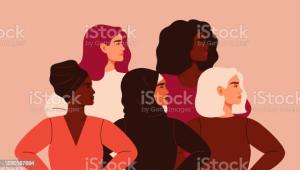
As I wrote in Part I, in failing to just accept that, on the curve of “femininity,” most people with XX chromosomes (otherwise known as girls and women) will cluster somewhere that does involve wearing skirts but probably doesn’t involve spending two hours a day on makeup (and that people far to each side of that clustering are no less female than those within it), we have unintentionally made womanhood smaller.
Hence, if the first problem with “girl power” is that it leaves a lot of less feminine girls and women out of a “normative womanhood” tent that should be as broad culturally as it is biologically, the second problem with girl power is that it incentivizes even those of us who remain within that tent to flatten the intragroup variance between us to prove that we belong.
Not All Women
Let’s go back to the 2000 film, “Miss Congeniality,” in which our 1970’s feminist prototype, FBI agent Grace Hart, is transformed into a 1990’s “girl power” prototype.
There is a scene where all the evening-gown clad beauty pageant contestants are asked: “What is the one thing our world needs?” Grace, still the old-school feminist FBI agent underneath her pretty makeup and elegant dress, confidently answers: “That would be harsher punishment for parole violators.” Her answer is, of course, tone-deaf. Every other woman on the stage had teared up at the question before replying: “world peace.” Grace looks around, realizes this, and follows up her real answer with a fake one that echoes those of her competitors, thereby maintaining her “girlie-girl” disguise.
The scene is quite funny, but it also conveys a troubling reality of the “girl power” iteration of feminism: To maintain her beauty pageant contestant disguise, Grace doesn’t just have to change the way she looks; she also has to change the way she feels, thinks, and talks.
There are unlikely to be new genders invented to reflect the varying personality traits that differ on average between women and men but are not directly related to gender presentation or sexual preference (or, at least, so I assume). Hence, women that fall outside the female prototype for a given personality trait but have no interest in “identifying” some other way, wind up doing exactly what Grace does on that beauty pageant stage: flatten our personalities to fit the prototype, thereby restricting both our own authenticity and the possibilities for other women to be authentic.
My Miss Congeniality Story
When I was in my 20’s, I taught business communication full-time at a big state school. My students were a diverse mix of women and men, and they spanned all the different business majors because this was a required course.
The course had a universal exam at the end, where students would be tested on the semester’s concepts and then the exams would be graded—pass or fail—at random by other professors in the department. A faculty member could not grade her own students.
So, in practice, the exam was as much for teachers as it was for students. For younger and less experienced teachers especially, having a low number of students fail the exam was a mark of distinction, akin to getting excellent teaching ratings from students themselves.
My first year, I had a very low number of students fail the exam, in part because I had “graded hard” and made myself exceptionally available for extra help all semester, to make sure that my students were well-prepared. But my teaching ratings were not stellar.
This was a conundrum. I could be “softer” during the semester, and risk more students failing the exam. Or I could continue to be a “hard grader” and risk more less-than-stellar teaching evaluations.
Was there any third way?
I was not sure, but I knew that similarly “hard grading” male colleagues got better student ratings. And I knew that I was at least as warm, generous with my time, and available as they were.
If the problem was that I was a woman, I was pretty sure that changing my appearance would not help. I am conventionally feminine, if very low maintenance. Think mascara with no foundation, and curly hair that I get professionally cut about once per decade (and often wind up wearing in a messy bun because I didn’t make the time to do anything else with it). Still, among my female colleagues, I was not an outlier; I fit in just fine aesthetically.
I knew several of my male colleagues with high teaching ratings well enough to know that, like me, they were straight-shooters that did not buffer necessary criticism with unnecessary praise. But I didn’t know any female colleagues like that.
So, like Grace Hart on the beauty pageant stage after her makeover, maybe my problem was that I looked more or less like the other women, but I didn’t think or talk like them.
The next semester, I decided to try something: I kept grading just as “hard.” But I tried to sound very regretful, and a little less sure of myself, while doing it. “Your punctuation in this paragraph is wrong, here and here and here, which is part of why it’s a D” became “I think that some of the punctuation issues we have in this paragraph…here, I think, and here…need to be addressed, in order to improve our grade next time?”
It was humiliating, and it was inauthentic. But it also worked.
My exam failures stayed low, and my student ratings shot up. I was the youngest faculty member in the program, and among its most successful. Girl power?
It didn’t feel so powerful.
After all, in addition to the stress of staying “in character,” I was failing to provide an example of a conventionally feminine-appearing woman that expressed care in a way that was closer to traditionally masculine than feminine, which is what I would have done if I had just continued to be myself.
This is no excuse, but there was also no one to provide that example for me. Probably because most women like me—that sizable minority of us that are naturally disposed to think of harsher punishment for parole violators before world peace as the first problem that needs to be solved—learned, as I did, to change our answers.
On and on that reductive, dispiriting cycle goes, flattening the many differences between us as individual women and men, and thereby creating a genuine demand for some other way to be and spawning all these nonsensical, minute identities when the real solution is to just accept and be ourselves.
Not All Men, Either
For every difference between women and men that exists “on average,” there are individuals that do not fit. That is why it’s an average. Most of us are both rules and exceptions.
Unlike most women, I am less nurturing than my traditionally masculine husband; but, like most men, he is more stoic than I am, even as he is also more nurturing. Meanwhile, my mom is a picture of nurturing femininity; but she is also prototypically “masculine” in the sense that she is more interested in things like fixing computers than my traditionally masculine dad, whereas he and I are two peas in a pod in that we speak a lot of words (which is, on average, a feminine inclination).
In the end, the girl power prototype needs to be put back in its place as merely a subset of womanhood that reflects most of us in part, some of us in full, and some of us not at all. Womanhood must be big enough for all women, because it includes all of us equally.











